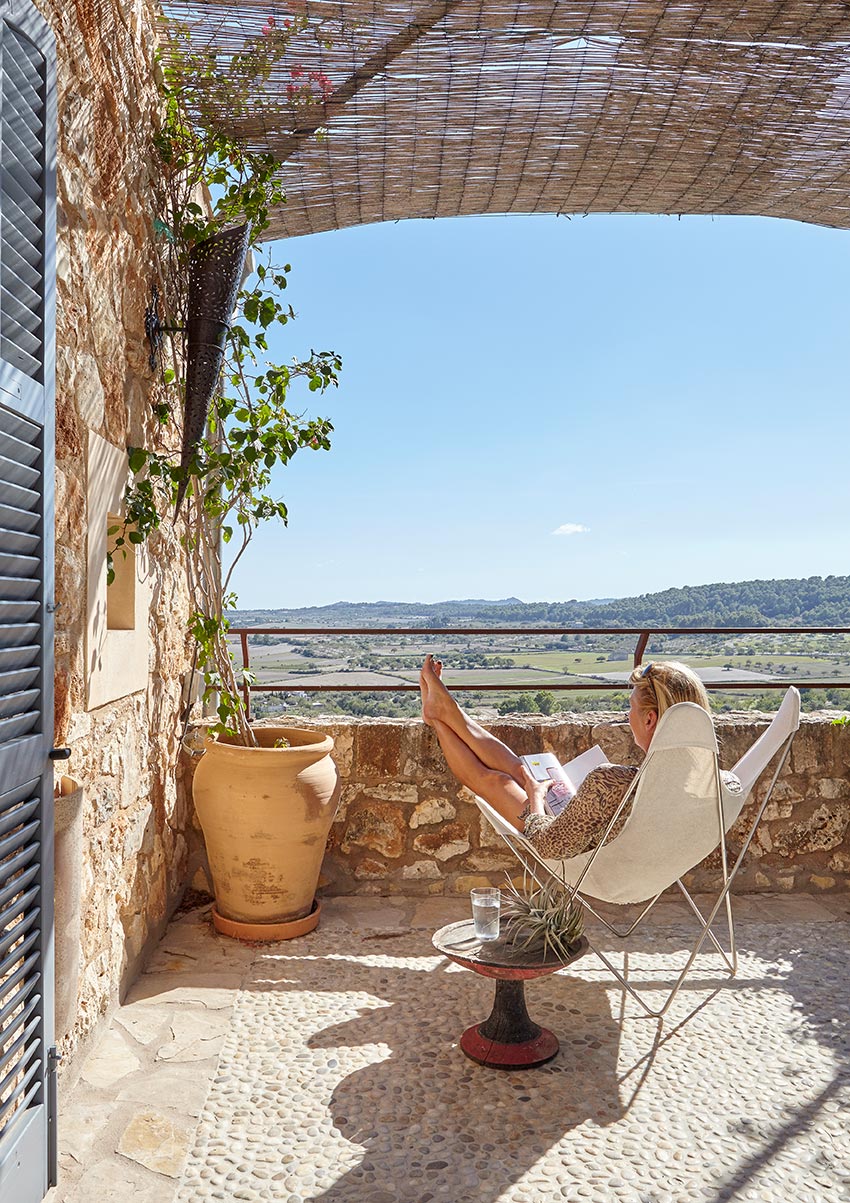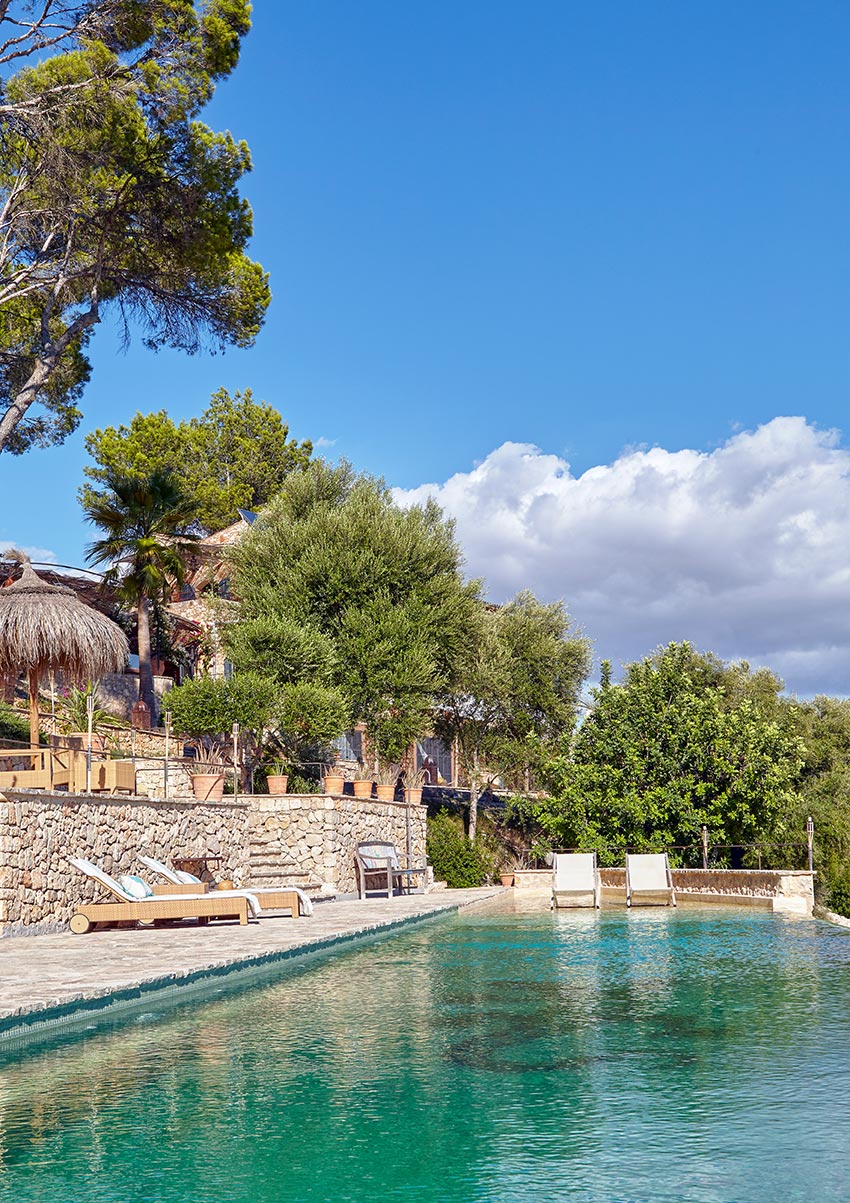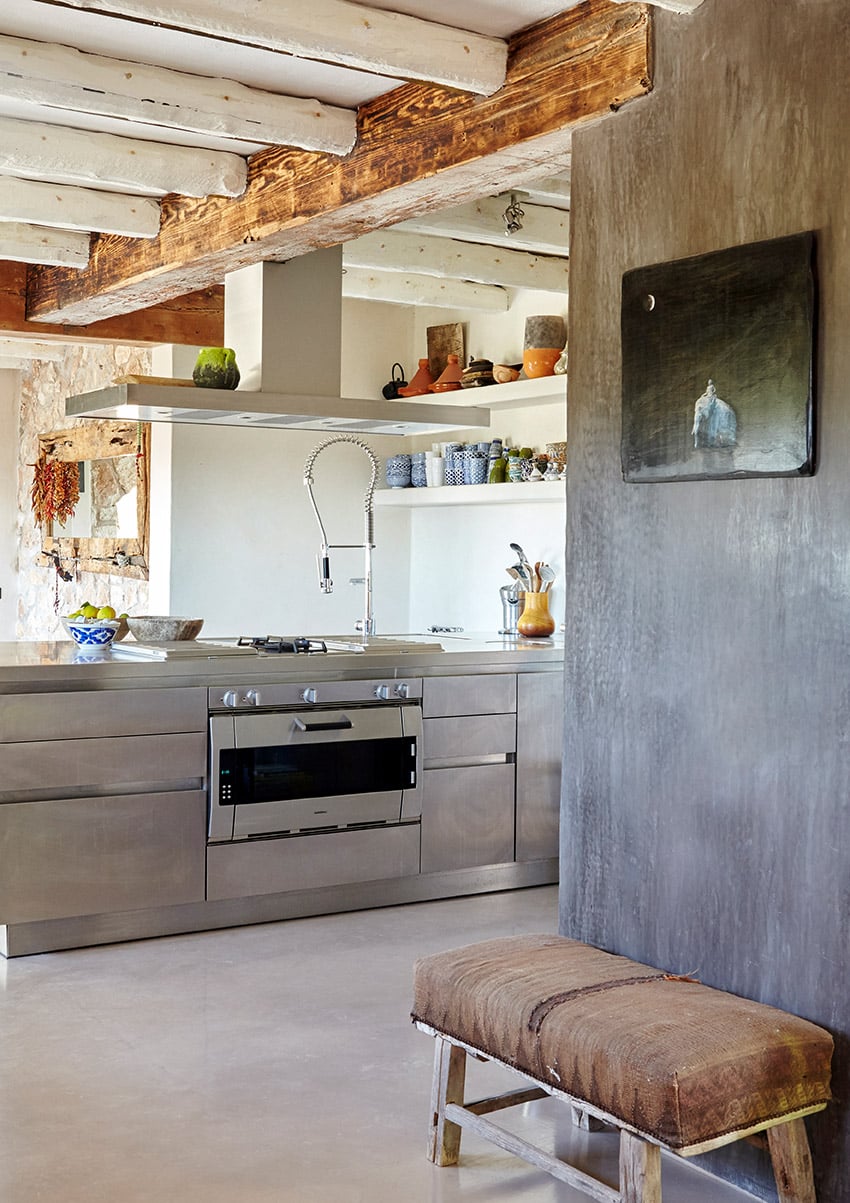A tranquil, envy-inducing holiday house, Osa Mayor is situated almost slap-bang in the middle of the island of Mallorca. So it’s a little surprising to discover that when homeowners Brenda Ooteman and her partner Roland first discovered the island, they did so as sailors. Hailing originally from Holland, the couple had a boat on which they regularly holidayed with their children, and they often docked at Palma de Mallorca.
Soon, however, the family began exploring the island’s natural beauty beyond the spectacular coastline, venturing further and further inland. And about 12 years ago, they identified the area in which Osa de Mayor is now situated – farm territory in the centre of Mallorca with several villages close by – as the place where they would like to buy or build a holiday home.
“It was the place, not the house that attracted us,” says Brenda, explaining that they weren’t looking for a fancy house, but for a beautiful place in nature. She says this part of Mallorca has almost no tourists and describes it as “hilly, with almond trees and vineyards growing between little old dreamy villages”. The village closest to Osa Mayor is picturesque Sant Joan, where there is a traditional weekly farmers’ market at which, says Brenda, you can still buy a donkey if you happen to need one.

After searching for a while, in around 2007 they found and bought this house. Situated down a simple sandy track, its location fulfilled all Brenda’s desires for a place that might be found along “a road that makes one wonder where it ends… Will paradise be discovered and unfold?” At Osa Major, paradise is definitely not very far off.
While the house wasn’t originally a Mallorcan finca (farmhouse), it was built in a completely traditional way. When they bought it from its original Dutch architect-designer and previous owner the structure consisted only of walls and a staircase: the build had been halted for several years when an archaeological site was discovered during construction. The ceramics and other artefacts that were unearthed and carefully catalogued – some of which are 3 000 years old – now reside in a nearby museum.
Because of the time taken for the archaeological dig, the required state permit to build on the site had expired, and it took three years to get a new one. During this time Brenda and Roland spent plenty of time visiting the site.
“It was good,” she says of a period of time that would have frustrated most people no end. “We learnt so much about the site – where the winds came from, how the sun changed with the seasons. We’d go there with a picnic and there would be sheep wandering around the place – there was an owl living in one of the rooms at one time too.”
On one of these visits, they made an additional and very special discovery: a tiny abandoned puppy, which they adopted and named Osa (Spanish for bear) after the property itself. She’s now an adult dog and Brenda’s constant companion. The family now also has two other dogs: Tati and Pippa.
Eventually, once the requisite building permit had been obtained and a certified Spanish architect located who could draw up the house plans, Brenda set to work in earnest. By this time, she knew exactly what she wanted, and what could be done away with. The existing skeleton of a house, she says, was too old-fashioned in terms of how the interior was laid out, and she was determined to take away as many interior walls as possible.
“We wanted space – for us, accustomed to the small living spaces typical of Holland, space is luxury. And I also wanted every bedroom to have its own bathroom. That gives everyone their privacy and adds to the feeling of being in a luxurious space.”

The result is that the exterior of the house has a gloriously traditional look, while the interior is contemporary in style, with a marked emphasis on natural, earthy materials. The interior walls, for example, are finished using a traditional Moroccan lime-based plaster called tadelakt. The basic white lime plaster comes from the High Atlas Mountains in Morocco, but it can also be coloured – as has happened in this house – using pure pigments. The subtle colour (in Osa Major pale green, sandy beige and off-white tints, carefully and individually chosen for various different rooms, have been added to the plaster) is built up layer by layer, and then to finish it, the plaster is polished by hand using stones – an absolutely key part of the process, as the word ‘tadelakt’ means ‘to rub in’ or ‘to massage’. This gives it a very hand-made, individual and slightly imperfect finish. The final step is a treatment with a natural soap solution (olive oil or black soap) that makes it water-resistant.
“For me, the best way to decorate a space is to keep the base of the interiors very clean and simple with beautiful floors and finishes. This means that if someone comes into the space and there’s absolutely nothing there, it will still look lovely. And then you can add – or if you like, accessorise with – textiles, colour, whatever.” The result is an interior that is very much a naturally inflected, loose and effortless one – and one that avoids ever seeming overtly or self-consciously styled.

Having previously used the house as a holiday home, Brenda and Roland have recently been spending almost all their time here. Here they will host guests and gatherings such as yoga retreats – after all, to what better use could the seven bedrooms in the house plus additional tipis up on the hill be put?
Brenda says she wants to offer healthy meals, massage, yoga, biking and create an interior showroom of sorts too: everything in the house, from baskets and ceramics to the beautiful textiles that Brenda collects wherever she travels, will be for sale. A range of local products will be available too, including the famous digestif of the Balearic Islands, hierbas – made on Mallorca from wild herbs and alcohol since the Middle Ages and excellent drunk over ice after dinner – and bags manufactured to Brenda’s designs from bright and bold local fabrics similar to those used to upholster cushions for the pool area at the house.
The central architectural feature of the house is its arresting, sculptural staircase. Built to replace the previously existing version (which took up too much space for Brenda’s liking) it links the multiple floors of the house. There’s a basement level that contains a casual living-relaxing space with built-in banquettes perfect for stretching out with a good book, and leads out onto a charming, narrow terrace.
One floor up is the expansive open-plan main living area, encompassing a beautifully equipped kitchen – which leads out onto another lovely large terrace with gorgeous views of the verdant surrounding countryside – plus a dining space and another living area. There are also two bedrooms, both en suite, on this floor, which Brenda says is definitely her favourite part of her home. Another flight of the staircase takes one up to the main bedroom floor, which features four en suite bedrooms, and then a final series of stairs heads up to one last bedroom situated in the eaves.

Much of Brenda’s chosen furniture is handmade, and all the decor accessories – textiles, glassware, ceramics, basket ware – feature a focus on the natural and were usually purchased by her on her travels around the world. Among these are eye-catching hanging lamps that turn out to be made from repurposed Indonesian rice pots, and simple wooden side tables made from recycled old Burmese teak. Some of these were made in Holland, and others by a local woodworker.
Brenda also enjoys collecting glassware, especially bottles and vessels in old-fashioned shades of green, but her great love is textiles. Beautiful fabrics are on show everywhere in this home. There’s the exquisite bed linen, for example: Brenda prefers either Egyptian cotton or pure linen from the high-end Italian store Society, and only in either pure white – essential here in the hot summer months, she says – or subtle tones of sandy beige. And in the more public areas of the house, wall hangings, throws and gorgeous upholstery fabrics constantly catch the eye.
“I always buy textiles,” says Brenda. “I don’t always know what I will do with them or where I’ll put them. I just buy what I love, which tends to be older, of high quality and richly coloured. And sometimes I’ll wear a piece of fabric first, then put it on a bed.” The end result is that the textiles and other artefacts that Brenda sources from many different parts of the world and uses in her home all somehow go together – like a chain that is connected.
To book a stay visit osamajor.com.




